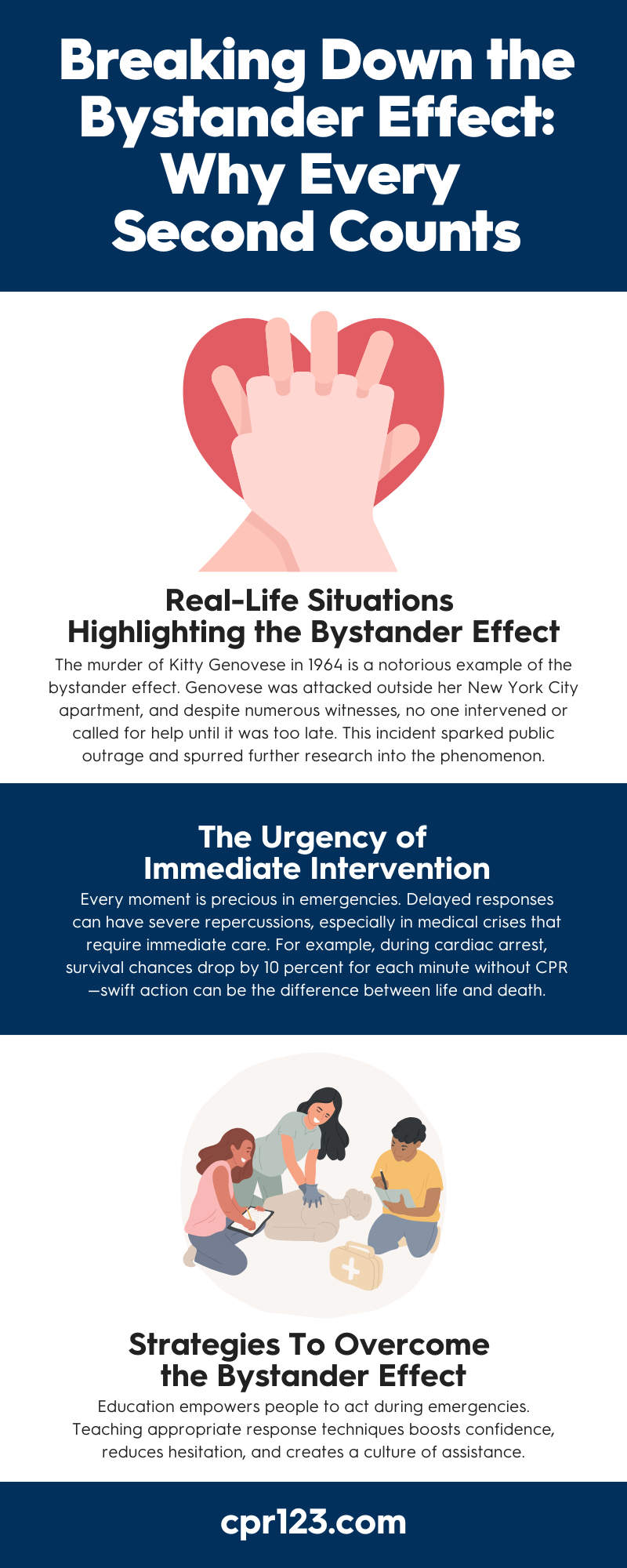Picture a busy street where someone suddenly collapses. Onlookers gather, yet no one steps up to help. This situation exemplifies the bystander effect—a psychological occurrence where people hesitate to assist during emergencies when others are present. Discover how to break down the bystander effect and why every second counts in an emergency.
What Is the Bystander Effect?
Social psychologists John Darley and Bibb Latané introduced the bystander effect in the 1960s, conducting experiments to understand why people become passive in critical moments. They found that the presence of others leads to a diffusion of responsibility, where individuals expect someone else to step in.
Social influence also contributes to this effect since people often look to others for behavioral cues. The situation might appear less urgent if no one acts, leading to inaction even when the situation requires immediate assistance.
This effect can manifest in various scenarios, from witnessing a crime to seeing someone in medical distress. Understanding its psychological underpinnings helps us devise ways to counteract this tendency and encourage proactive responses.
Real-Life Situations Highlighting the Bystander Effect
The murder of Kitty Genovese in 1964 is a notorious example of the bystander effect. Genovese was attacked outside her New York City apartment, and despite numerous witnesses, no one intervened or called for help until it was too late. This incident sparked public outrage and spurred further research into the phenomenon.
Cyberbullying presents another example of this phenomenon. Individuals in digital spaces may observe harassment but choose not to intervene, assuming others will. This passive stance perpetuates harmful behavior and leaves victims unsupported.
These instances underscore the adverse societal impacts of the bystander effect, and by acknowledging its presence, we can adopt measures to mitigate it and promote a culture of active involvement.
The Urgency of Immediate Intervention
Every moment is precious in emergencies. Delayed responses can have severe repercussions, especially in medical crises that require immediate care. For example, during cardiac arrest, survival chances drop by 10 percent for each minute without CPR—swift action can be the difference between life and death.
Immediate intervention also prevents escalation. Early involvement can defuse violent or harassing situations, safeguarding potential victims. Prompt action discourages passive observation and inspires others to emulate it.
Recognizing the importance of timely responses underlines the need for widespread education and training. We can diminish the bystander effect’s impact and cultivate safer communities by equipping people with the skills and confidence to act.
Strategies To Overcome the Bystander Effect
Recognizing signs of the bystander effect and consciously deciding to act are crucial first steps. Instilling a sense of personal responsibility motivates individuals to intervene, even amid passive observers.
Education empowers people to act during emergencies. Teaching appropriate response techniques boosts confidence, reduces hesitation, and creates a culture of assistance.
Additionally, public campaigns, workshops, and training programs raise awareness and encourage proactive behavior to develop collective responsibility and emphasize mutual care.
Workplaces’ Role in Addressing the Bystander Effect
Workplaces have a unique role in tackling the bystander effect. Organizations can empower employees to act during emergencies by fostering a culture of safety and responsibility, enhancing individual protection and company reputation.
Implementing clear emergency policies and procedures is vital. Employees should know whom to contact, what steps to take, and how to access resources. Clarity on these procedures will reduce uncertainty and encourage decisive action.
Regular training sessions further benefit workplaces by preparing employees to respond effectively in crises, combating the bystander effect. Training should cover a variety of scenarios, from medical emergencies to harassment incidents.
Online Corporate CPR Training: A Key Resource
Offering online corporate CPR training is one way workplaces can prepare for emergencies. These courses equip employees with lifesaving skills, enabling confident responses to medical situations.
Online CPR courses offer flexibility, allowing employees to learn at their own pace. Topics include recognizing cardiac arrest, performing chest compressions, and using automated external defibrillators (AEDs). This knowledge facilitates quick and effective action during emergencies.
Beyond skill improvement, CPR training nurtures a culture of responsibility. Trained employees are more likely to intervene, reducing the bystander effect’s impact. This proactive approach transforms workplaces into safer environments for all.
Promoting a Culture of Proactive Behavior
Cultivating a proactive culture requires ongoing effort and reinforcement—organizations should recognize and celebrate individuals who act in emergencies to reinforce the importance of intervention.
Incorporating bystander intervention training into corporate programs maintains awareness. These sessions teach employees to identify and respond to various situations so they can stay ready to act when necessary.
Consistent communication about the importance of intervention is also crucial and keeps the conversation alive, emphasizing the value of mutual assistance while sustaining a sense of shared responsibility.
Leveraging Technology in Emergency Response
Technological advancements offer new avenues to address the bystander effect—mobile apps and online platforms provide resources and guidance for individuals in emergencies, promoting informed decision-making.
Some apps offer CPR instructions or connect users with emergency services, while others alert nearby responders. By utilizing technology, individuals can access support quickly, minimizing hesitation.
Organizations can also enhance workplace safety through technology by implementing emergency notification systems or digital training programs so employees have essential information readily available to provide effective crisis responses.
Building Confidence With Practice
Confidence in emergency response stems from practice. Regular drills and simulations allow individuals to apply their knowledge in controlled settings, building familiarity with necessary actions.
Workplaces can organize emergency response exercises to reinforce training concepts, and drills should cover diverse scenarios so employees feel prepared for various situations. Also, providing feedback during these practices can refine their skills.
Individuals become more comfortable stepping forward in real emergencies by building confidence through practice, reducing the bystander effect’s impact, and encouraging timely intervention.
The Ripple Effect of Action
Responding to emergencies inspires others to follow suit—witnessing someone step forward increases the likelihood of others doing the same, establishing a culture of intervention where people feel empowered to help.
Organizations can magnify this effect by sharing successful intervention stories since highlighting positive outcomes reinforces the value of quick action and motivates others.
Organizations contribute to safer environments within and beyond the workplace by maintaining a culture of intervention. This proactive approach benefits society by reducing the bystander effect’s prevalence and promoting collective action.
Conclusion
Understanding how to break down the bystander effect and why every second counts in an emergency enables individuals to become active participants in adverse situations. Continuous effort, education, and technology encourage proactive behavior and guarantee timely responses in emergencies. Together, these strategies create a safer, more responsive society.








